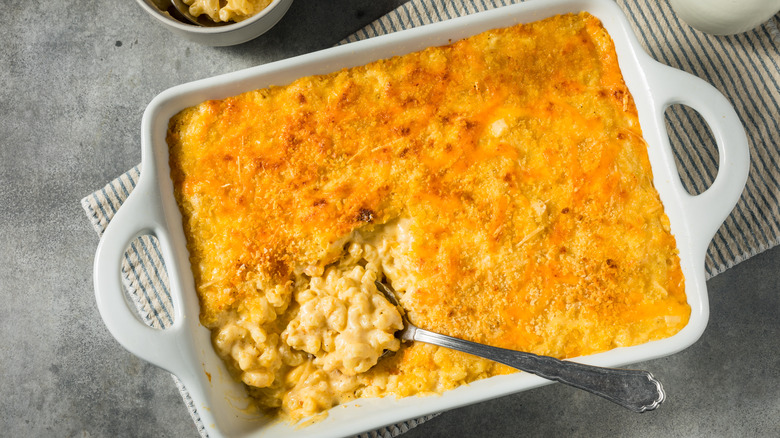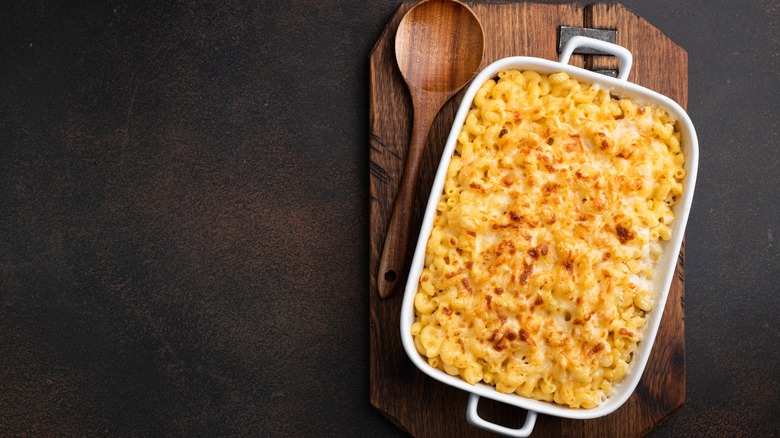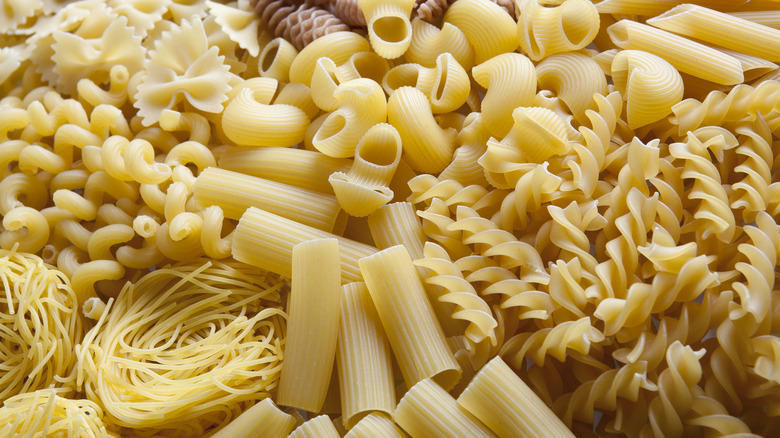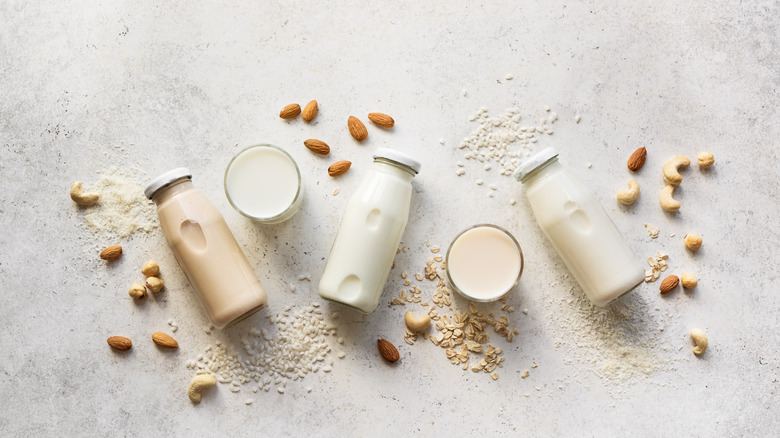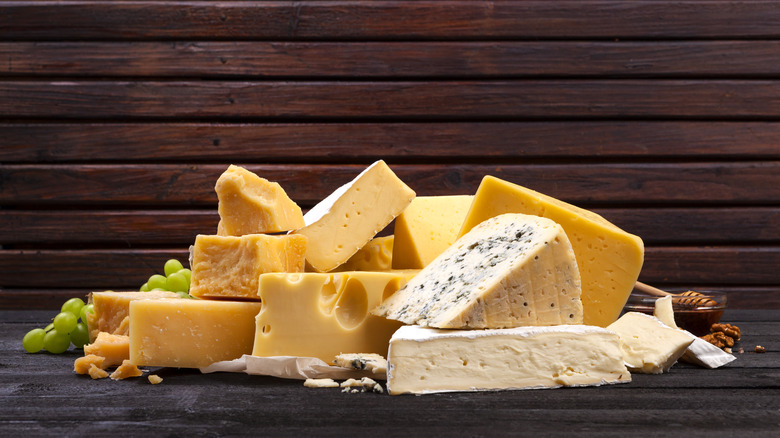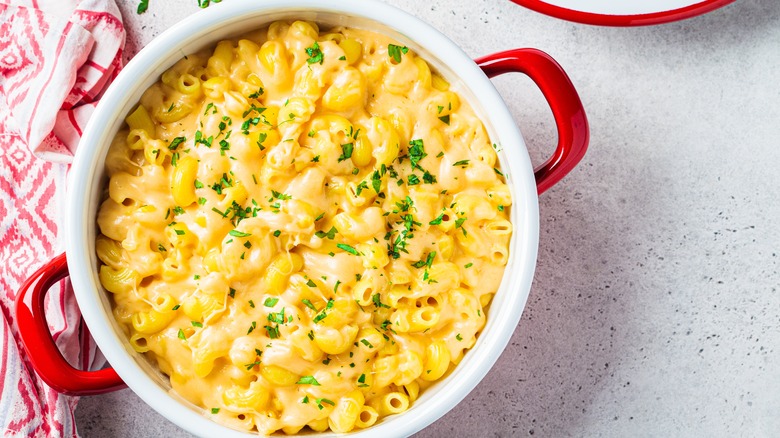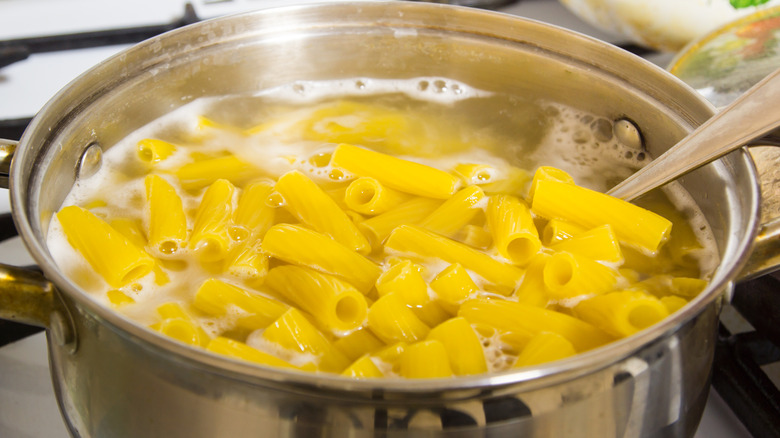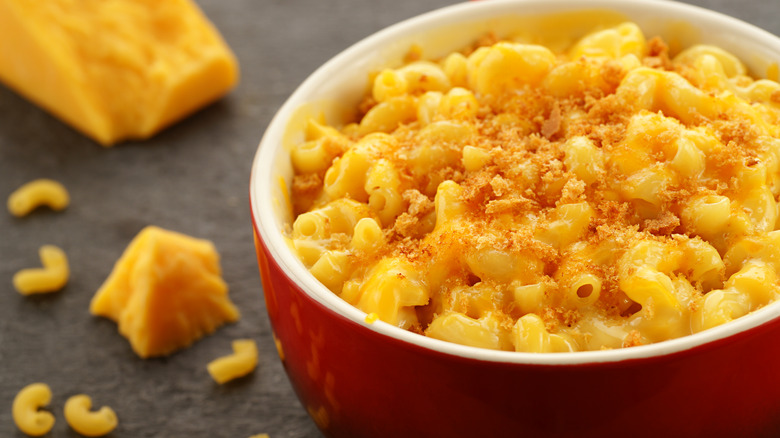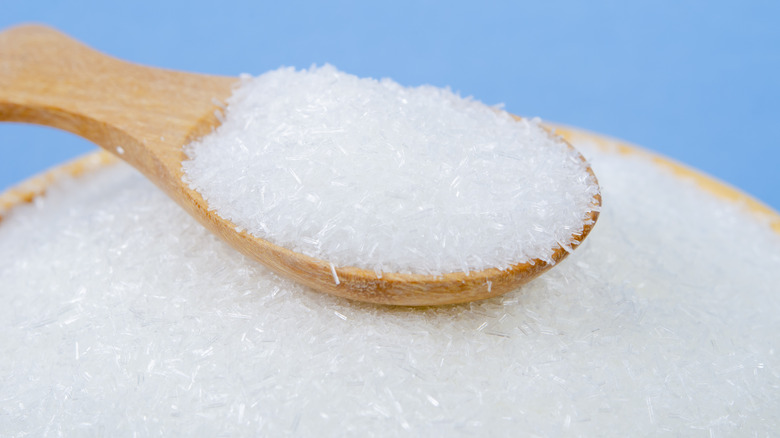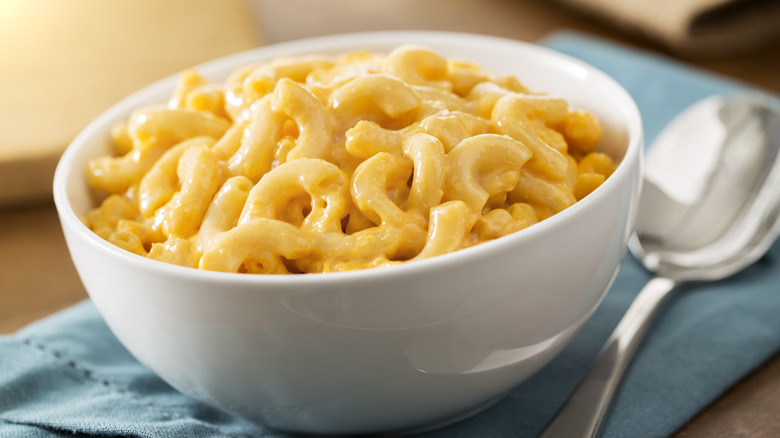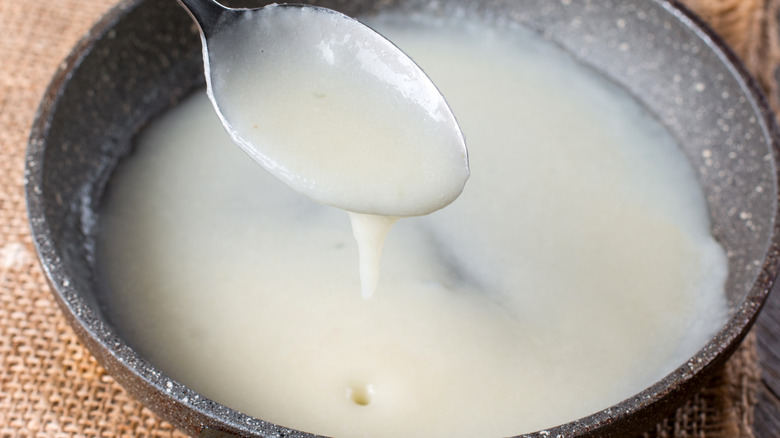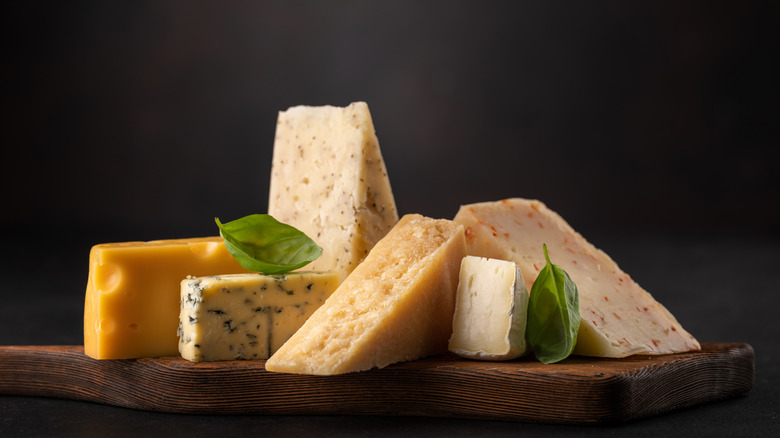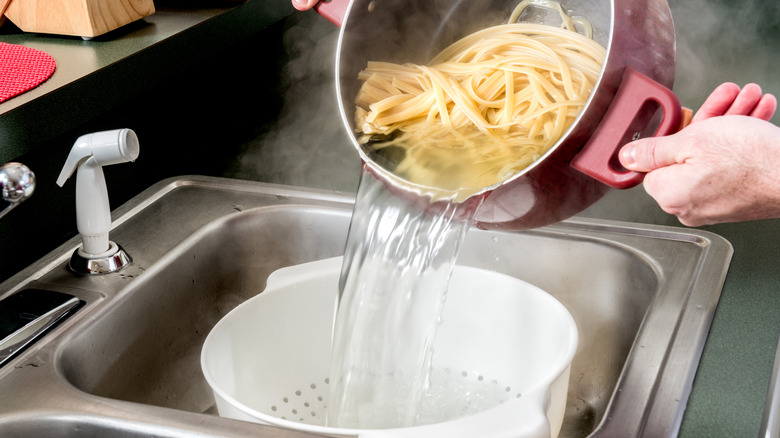Mistakes That Are Ruining Your Mac And Cheese
Mac and cheese is one of the most classic comfort foods out there. As children, we grow up eating the boxed versions and salivating over alphabet-shaped noodles drenched in a creamy cheese sauce. As adults, we still crave these things — but now we make the macaroni and cheese ourselves. A homemade macaroni and cheese dish just tastes better, especially because you can customize it to your liking, adding in whatever cheese, seasonings, and toppings you love.
But because there are so many ways to make macaroni and cheese your own, it can be quite easy to run into a few mistakes while cooking. As a simple dish, making even a small mistake with mac and cheese might ruin it completely. For this reason, it is always best to be mindful of the missteps you should avoid. Thankfully, the biggest mistakes people make when cooking a homemade macaroni and cheese dish are also the most common. With a bit of information, you can avoid falling victim to them.
You aren't baking it before serving
Baking the mac and cheese is the best way to get crispy corner pieces and a golden top without losing the creaminess on the inside. Thus, one major way to mess up mac and cheese is to not bake it before serving. Because macaroni and cheese is so simple, your method of cooking it has an outsized impact on flavor and texture. When you throw your mac and cheese in the oven, you are giving it a more complex texture profile.
If fully baking the dish feels like too much of a hassle, or you don't have the time, try using the broiler setting on your oven. This cooking method transforms boxed macaroni and cheese by saving you time without compromising the taste and texture of the dish. After cooking your mac on the stove, use the broiler to bronze the top layer; the moisture on the inside will remains trapped under the crust. Because the broiling technique takes less than 10 minutes, it's easy to keep your dish from over baking.
An important part of getting the bake right is to give the dish time to rest. Without this, the mac and cheese will fall apart when you cut into it; the goal is to have a baked mac and cheese that cuts like casserole or lasagna; resting time is key to solidifying.
Choosing the wrong pasta shape
When you think of macaroni and cheese, you likely think of elbow noodles. But in a world with a myriad of pasta shapes to choose from, elbows don't have to be the one you make mac and cheese with. From aspects like length, thickness, and even texture, different types of pasta will hold the sauce and toppings differently, and therefore affect how the overall dish tastes.
With mac and cheese, it is especially important for the sauce to be able to latch on to the noodles. For this reason, it is most important to use a noodle with small ridges or even a gap, which can trap or create a well of sauce. Orecchiette, which is pasta shaped like little ears, are hollowed-out, and this let's the cheese sauce pool into the scoop. A tube-shaped ziti variety can pair well with the thick, cheesy sauce of a macaroni and cheese dish, since the ridges and hollow inside will also trap sauce.
Another thing to look for is the pasta type. Egg pastas, pasta made with semolina, or bronze-die extruded pasta have a grainier texture that gives the fat globules something to latch onto. This means more even coverage of your cheese sauce over the pasta. Overall, you want to avoid longer noodles like angel hair or fettuccine, which are bound to let the cheese sauce slide right off the noodle and leave it on your plate.
Adding in the wrong milk
Typically, macaroni and cheese is made with very few ingredients — pasta, butter, cheese, flour, and milk. Because this is a simple ingredients list, the right ingredients are extra important, especially milk. The best milk to use for macaroni and cheese is be thick milk, so your dish becomes creamy.
If you're into a more southern version of a mac and cheese, use buttermilk. Buttermilk is tangy, which will add a more complex flavor to your dish, and it is significantly thicker than whole milk, which makes it perfect for avoiding an overly runny cheese sauce. If you don't have buttermilk lying around, and you are an avid coffee drinker, you likely have a carton of half-and-half readily available, and you can use that as your milk substitute instead.
Half-and-half has a higher fat content than regular milk, so it will act just as milk would with the added benefit of thickening your sauce a little bit more. To take it a step further, using evaporated milk in mac and cheese would work just as well. This milk is smooth and already very thick, so it will take less time to thicken up on the stovetop, resulting in a quicker, easier cheese sauce and less time spent over the stove for you.
Using the wrong cheese
You can't overlook the type of cheese you add into a macaroni and cheese dish. Unfortunately, one of the most common mistakes of making homemade mac and cheese is using pre-shredded cheese.
While it is convenient, pre-shredded cheese is processed and sometimes includes anti-caking agents, therefore leaves a lingering pasty texture when melted down. No one wants to go through all of the trouble of making a homemade mac and cheese for the dish to end up broken or sandy!
Pre-shredded cheese also doesn't melt down well, similar to aged cheeses, which you should also avoid. When cheese ages, the proteins become a little bit weaker, and that makes the cheese more difficult to melt down and re-bond. This could result in the cheese sauce being grainy, which is an unpleasant texture unwelcome in mac and cheese.
Some of the best cheeses to use in a mac and cheese are sharp cheddar and Monterey jack. The latter is creamy all on its own, so once it hits the pot, it melts very easily and transfers that creaminess into the consistency of the mac and cheese dish. Sharp cheddar has a pungent flavor that is also smooth, so it will hit both points of note for your cheese sauce — a tangy flavor and a creamy texture.
Not adding toppings
Every food is better with toppings. Macaroni and cheese is no different. Toppings can take a simple dish and elevate it just a touch, and they can make it more fun. Adding bacon is a classic mac and cheese tip, one that adds the crunch and salty flavor of a favorite breakfast side. Another great topping is breadcrumbs — this is especially smart if you plan to pop your baking dish into the broiler or the oven, because the breadcrumbs will toast, making an already crispy top even more delectable.
If you want to try a less classic route, you can get the same crunchy effect by using Cheez-Its. Once you crush up the crackers, sprinkle the powder across your macaroni and cheese as if it were a dust storm of nostalgia. You can try the same technique with different type of snack, too. Perhaps Takis or Doritos, which both have similar cheesy and spicy options and will add a new, seasoned taste to the top of your mac and cheese.
For a more sophisticated approach, tossing scallions over your mac and cheese will make the dish feel a little less heavy. Because mac and cheese is such a rich meal, the scallions add bite and make the dish feel like you're eating in the garden, even if you're 10 floors up.
Overcooking the pasta
Pasta is easy to make but also easy to overcook. Especially if you're going to bake the pasta after stirring it together on the stovetop, it's important to be mindful of how long you're cooking the dish for over all. When boiling, you should aim to undercook the pasta. It is important to boil your noodles to the point of al dente, or even a bit less, so that when they go in the oven, they do not wilt under the heat.
Overcooked noodles become soggy so that even if they have ridges or hollowed-out centers, they will fail to hold the cheese sauce and will fall apart. You're more likely to get a soupy or stewy spoonful than you are to get pliable pasta coated in rich sauce.
If you do happen to overcook your pasta, you might be able to save the noodles for another dish. You can toss them in a pan with butter or oil and intentionally get them crispy in order to create more of a crispy pasta. Ideally, you should aim to cook your pasta for 8 to 10 minutes, though the time will vary by package. The best way to avoid soggy noodles? Taste as you go.
Trying to over-elevate it
While adding toppings and changing the milk are great ways to make your mac and cheese dish more elevated, making too many changes will overcomplicate the meal, veering it further and further from the classic dish. Like the saying "too many cooks in the kitchen," too many ingredients in a macaroni and cheese will rub elbows and start fights.
Rather than adding a wild, unexpected flavor, you can use very simple techniques — and interesting ingredients — to elevate mac and cheese without changing it. For example, hummus can be stirred in to both thicken the sauce and add big flavor and protein. You won't get that from a classic or boxed mac and cheese. Alternatively, Greek yogurt can be swapped in place of milk or cream. The significant fat content contributes to a thicker sauce, and the acidity mirrors buttermilk. Whatever technique you choose to elevate your mac and cheese, try not to use too many different methods at once.
Under or over-seasoning
Seasoning your mac and cheese is just as important as seasoning any other meal. It starts with salting the pasta water, which is a tip you should always use when boiling noodles. Many times, people forget to add seasoning to their cheese sauce, because it seems the various flavors of the cheese will provide sufficient seasoning. While cheese does have a high salt content, that flavoring will be dulled out by the mixture of the pasta, which means you have to take the extra step of seasoning your sauce.
To avoid the risk of adding too much seasoning — which can easily ruin a dish you've worked so hard on — you can keep your seasoning simple. A small amount of nutmeg, for example, will add a bit of spice and a lot of complexity to your macaroni and cheese dish. Because mac and cheese is usually a mild level of spice, nutmeg provides an extra kick to spice up the meal.
You can also keep it classic with just salt and pepper, but be careful not to add too much sodium. If you have a heavy hand, to counteract the salt, try adding lemon or lime juice — acids help balance salty flavors in food. You can also use dairy, and since you're already adding milk to your macaroni and cheese, this might be the most seamless way to save your meal.
Pouring in too much liquid
If you do use milk to counteract salt, be careful about making your cheese sauce too runny. As mentioned earlier, baked macaroni and cheese should have the consistency of a casserole, but adding too much liquid will quickly turn it into soup. Thankfully, there are some quick fixes if you're in a pinch and worried your sauce has become too runny.
Adding corn starch or flour can work to thicken your cheese sauce. You can add it in early in the cooking process, or mix a small amount in right before serving. Luckily, neither starch will add any flavor or seasoning to your dish, so your flavors won't be thrown off. Other quick fixes are too leave the macaroni and cheese dish in the oven for a few minutes longer — or let it simmer on the stovetop — to give that liquid more time to soak up into the noodles.
And remember — let your macaroni and cheese rest. Like mentioned earlier, this is a crucial part of the baking process. The dish will continue to cook while it rests, so resting provides more time for the liquid to thicken.
Forgetting to make a roux
A roux is a combination of flour and fat that is used to thicken sauces. Making a roux is simple; you melt equal parts fat and flour together over a stovetop and stir until the liquid smells toasted. Afterwards, you can spread your cheese into your roux batch by batch, melting it slowly to form a sauce.
In mac and cheese, the fat you use is most likely going to be butter, and you should expect to spend about five minutes cooking a white roux on the stovetop. Going any longer than this can overcook your rough, which according to Rachael Ray, will make your cheese sauce feel grainy.
Another thing that can disrupt your roux is getting the measurements wrong. Although Rachael Ray uses equal parts butter and flour, if she's making a larger amount of roux, she'll give the butter one extra tablespoon just to increase the creaminess. To elevate her own roux, she also adds in milk, and lets all of that thicken just enough to stick to the back of the spoon. And as always, it is important to season your roux with salt and pepper — this will impart more flavor into your mac and cheese.
You're only using one type of cheese
As already said, cheese is the most important part of this dish, and relying on a single type of cheese for a macaroni and cheese dish is a sure way to be disappointed. While you should still keep in mind the type of cheese you're using — no aged cheeses, and no pre-shredded! — using multiple varieties of cheeses will do well to add complexity to the flavor profile of your dish.
Martha Stewart uses a combination of cheeses to achieve a flavorful, tangy bite in her mac and cheese. In addition to a classic cheddar cheese, Stewart also adds gruyere and Pecorino Romano, both of which add sharp flavors that can't be missed. Pecorino has a tangy, savory taste which will add a zing to the flavor of the cheese sauce. Gruyere also has an added sweetness that makes the macaroni and cheese more hearty, which is perfect to keep it a classic comfort food.
The sharp flavor of cheddar cheese also pairs well with Parmesan cheese, which is salty while also having a bit of a nuttiness. The cheddar works to smooth out this texture so your cheese sauce remains creamy and unaffected in texture.
Not saving the pasta water
Any recipe you have ever come across has likely encouraged you to save your pasta water. This is because pasta water is a key ingredient, according to Rachel Ray. You can save your pasta water by gathering some in a mug or a measuring cup and putting it aside before straining your noodles.
Because you seasoned it, the pasta water will be salty and will have the flavors of starch that exist in most pasta noodles. The pasta water is great to use if your macaroni and cheese has become too thick and you need the consistency to be loosened. Whereas adding regular tap water or milk to loosen the sauce will take away from the seasoning you've worked so hard to cultivate, adding in pasta water will bring the noodles back to their natural flavors and bring all your flavors together in a unified way that will make your dish taste that much better.
The starch emitting from the noodles when they boil also works to make sure your sauce doesn't get too liquidy — remember earlier, when we said adding starch can help make your mac and cheese less runny? The natural starch from the noodles makes the pasta water perfect for loosening your sauce without overdoing it, so your macaroni and cheese maintains the perfect consistency.
Static Media owns and operates TheTakeout, Tasting Table, and the Daily Meal.
